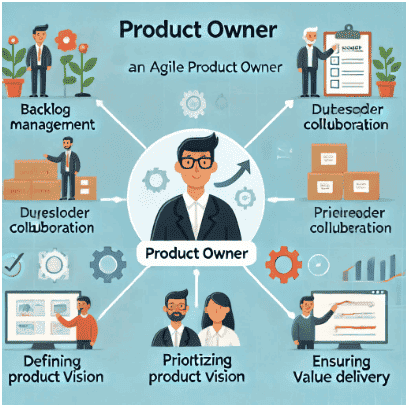








The common difference between product owner and product managers is as follows:
| Aspect | Product Owner (PO) | Product Manager (PM) |
|---|---|---|
| Goal | Deliver incremental value through sprints. | Deliver market-winning products aligned with business goals. |
| Backlog Management | Owns and refines the product backlog for the team. | Defines high-level features and epics that guide backlog priorities. |
| Customer Focus | Ensures user stories meet customer needs within sprints. | Understands the market, gathers feedback, and defines product direction. |
| Value Delivery | Maximizes value delivered by the team in each sprint. | Ensures the product delivers business value and meets revenue targets. |
| Roadmap Ownership | Supports sprint planning and tactical execution of the roadmap. | Owns the product roadmap and defines product strategy. |


Agile organizations use this approach to position Business Analyzers as essential assets which support their strategic operations.


The One key service a Scrum Master provides to the Product Owner is:


An Agile framework is a structured approach that helps teams implement Agile principles and values like collaboration, flexibility, and continuous improvement. It provides guidelines, roles, events, and artifacts to help teams deliver value incrementally and iteratively.


A key measure of solution success in design thinking is user adoption and satisfaction. If users find the solution valuable, easy to use, and effective in solving their problems, it indicates success. Metrics such as Net Promoter Score (NPS), user feedback, and retention rates help evaluate its impact.


The best SAFe certification depends on your role and goals. Leading SAFe® (SAFe Agilist – SA) is ideal for leaders and managers, while SAFe Scrum Master (SSM) suits Scrum Masters. SAFe Practice Consultant (SPC) is best for transformation leaders. For product roles, SAFe POPM is recommended.
Also, explore: How to choose the best SAFe certification for your career growth.


Strategic themes in SAFe directly influence portfolio strategy, investment funding, and prioritization of Epics. They ensure alignment between business objectives and Agile execution, guiding decision-making across value streams. These themes shape roadmaps, resource allocation, and lean budgeting within the portfolio.


Scrum is an Agile framework that delivers products iteratively. It emphasizes short development cycles (Sprints), continuous feedback, and incremental improvements. Scrum teams use daily stand-ups, sprint planning, and retrospectives to adapt quickly and deliver value efficiently.


To get SAFe Agile Certification, follow these steps:


Continuous delivery and collaboration accurately describe Agile and DevOps. Agile focuses on iterative development and team collaboration, while DevOps enhances automation, deployment speed, and operational efficiency through CI/CD pipelines. Together, they enable faster, high-quality product releases.


The Lean Portfolio Management (LPM) team is responsible for managing the Portfolio Kanban in SAFe. This includes Business Owners, Epic Owners, Enterprise Architects, and Lean Portfolio Leaders, who oversee epic flow, prioritize work, and ensure alignment with strategic objectives.
Our privacy policy © 2018-2025, Simpliaxis Solutions Private Limited. All Rights Reserved